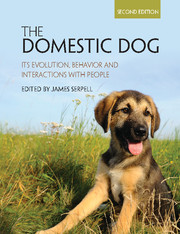Book contents
- Frontmatter
- Dedication
- Contents
- List of contributors
- 1 Introduction
- PART I ORIGINS AND EVOLUTION
- PART II BEHAVIOR, COGNITION AND TRAINING
- PART III DOG-HUMAN INTERACTIONS
- PART IV LIFE ON THE MARGINS
- 16 Variation in dog society: Between resource dispersion and social fl ux
- 17 The ecology and behavior of feral dogs: A case study from central Italy
- 18 Roaming free in the rural idyll: Dogs and their connections with wildlife
- 19 Dog population management
- 20 Epilogue: The tail of the dog
- Index
- Plate section
- References
20 - Epilogue: The tail of the dog
from PART IV - LIFE ON THE MARGINS
Published online by Cambridge University Press: 30 December 2016
- Frontmatter
- Dedication
- Contents
- List of contributors
- 1 Introduction
- PART I ORIGINS AND EVOLUTION
- PART II BEHAVIOR, COGNITION AND TRAINING
- PART III DOG-HUMAN INTERACTIONS
- PART IV LIFE ON THE MARGINS
- 16 Variation in dog society: Between resource dispersion and social fl ux
- 17 The ecology and behavior of feral dogs: A case study from central Italy
- 18 Roaming free in the rural idyll: Dogs and their connections with wildlife
- 19 Dog population management
- 20 Epilogue: The tail of the dog
- Index
- Plate section
- References
Summary
Origins and evolution
One of the disconcerting ironies of science is that often the more we discover about a particular topic the less we seem to know about it. In the concluding chapter of the first edition of this book, I reported confidently that the dog was domesticated from the grey wolf (Canis lupus) at least 12 000 years ago, and that future discoveries would probably reveal precisely when, where and how this happened (Serpell, 1995). Despite the passage of 20 years, however, and the many remarkable new advances in archaeology and molecular genetics reviewed in this new edition (see Clutton-Brock, Chapter 2; vonHoldt & Driscoll, Chapter 3), the scientific debate concerning the origin(s) of the dog continues to rage without any clear consensus emerging as to the most likely time and place of domestication, whether it occurred only once or multiple times, or even the reasons why our ancestors decided to share their lives with this large and potentially dangerous carnivore in the first place (Drake et al., 2015; Larson et al., 2012; Skoglund et al., 2015; Thalman et al., 2013). Whether the discovery of new archaeological remains, or further advances in morphometrics and/or genetic sequencing will eventually settle these questions still remains to be seen.
Widely accepted ideas regarding the selective processes that led to the emergence of the domestic dog from its ancestor(s) may also need revision. Twenty years ago, Coppinger & Schneider (1995) made a compelling case that much of the variation in the working behavior and head shape of dogs was a coordinated product of different levels of selection for juvenile or puppy-like aspects of behavior (neoteny/pedomorphosis), an argument that seemed to resonate with the canine science community at the time. Now, these authors, together with Kathryn Lord, propose a decidedly different view; namely, that breed-specific dog behavior patterns, the shapes of their faces and jaws, and even the quality and color of their coats are all regulated by a population of embryonic cells known as “neural crest cells,” and that these cells act, “as a conduit through which breed-specific adaptations are implemented” (Lord et al., Chapter 4).
- Type
- Chapter
- Information
- The Domestic DogIts Evolution, Behavior and Interactions with People, pp. 404 - 412Publisher: Cambridge University PressPrint publication year: 2016

